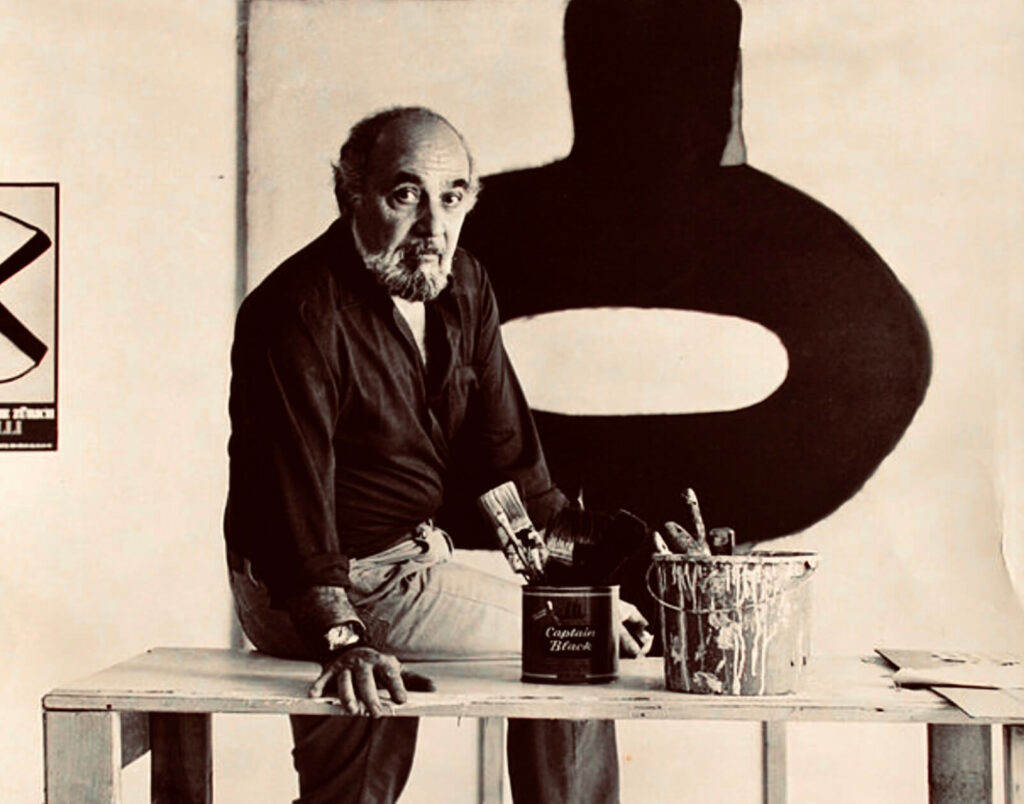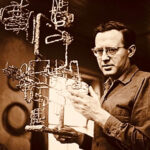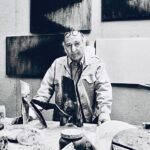Conrad Marca-Relli
Conrad Marca-Relli (1913-2000) was an American artist renowned for his pioneering work in collage and abstract expressionism. With a career spanning over six decades, Marca-Relli made significant contributions to the post-war American art movement. His innovative use of materials and his exploration of form and space have left an enduring legacy in the world of abstract art.

Early Life and Education
Conrad Marca-Relli was born Corrado Marcarelli on June 5, 1913, in Boston, Massachusetts, to Italian immigrant parents. His family moved frequently during his childhood, which exposed him to various cultural and artistic influences. This itinerant lifestyle, combined with his Italian heritage, played a crucial role in shaping his artistic sensibilities.
Marca-Relli’s formal art education began at the Cooper Union for the Advancement of Science and Art in New York City, where he studied from 1930 to 1933. Cooper Union was known for its rigorous training and emphasis on both technical skills and creative exploration. During this period, Marca-Relli was exposed to a wide range of artistic styles and techniques, which would later inform his unique approach to art.
Early Career and the New York School
In the early 1940s, Marca-Relli became associated with the New York School, a group of artists who were at the forefront of the abstract expressionist movement. This group included prominent figures such as Jackson Pollock, Willem de Kooning, and Franz Kline. Marca-Relli’s early works from this period were influenced by the gestural and spontaneous techniques characteristic of abstract expressionism.
Marca-Relli’s early paintings were primarily abstract compositions that explored the dynamics of color and form. However, he soon began to experiment with collage, a medium that would become central to his artistic practice. His transition to collage was marked by a desire to explore new possibilities in texture, depth, and composition.
Development of Collage Technique
Marca-Relli’s development of collage as a primary medium set him apart from many of his contemporaries. He began incorporating various materials into his works, such as canvas, burlap, and painted paper, creating complex and textured surfaces. His collages were characterized by their architectural quality, with forms that seemed to be constructed and deconstructed on the canvas.
One of Marca-Relli’s key innovations was his use of negative space to create a sense of depth and movement within his compositions. By carefully arranging and overlapping his materials, he was able to create dynamic and visually engaging works that challenged traditional notions of painting and sculpture.
Important Artwork: “The Battle” (1956)
One of Conrad Marca-Relli’s most significant and celebrated works is “The Battle” (1956). This large-scale collage is an excellent representation of his mature style and his ability to create powerful, evocative compositions using non-traditional materials.
“The Battle” (1956)
“The Battle” is a monumental collage that measures approximately 8 feet by 16 feet. The composition features a series of overlapping shapes and forms that create a sense of movement and tension. The work is dominated by shades of black, white, and gray, with occasional accents of red and yellow that add to its dramatic impact.
The title “The Battle” suggests themes of conflict and struggle, which are reflected in the dynamic arrangement of forms. The overlapping shapes create a sense of chaos and fragmentation, while the use of negative space adds depth and complexity to the composition. The work’s large scale and bold use of color and texture make it a powerful and immersive experience for viewers.
One of the most striking aspects of “The Battle” is Marca-Relli’s ability to convey a sense of movement and energy through his use of materials. The carefully arranged pieces of canvas and paper create a rhythmic and dynamic composition that seems to pulse with life. The work’s abstract forms evoke a sense of tension and conflict, while also suggesting a process of creation and destruction.
“The Battle” exemplifies Marca-Relli’s mastery of collage and his ability to create works that are both visually compelling and intellectually engaging. The sculpture’s exploration of themes of conflict, struggle, and transformation makes it a powerful and enduring work of art.
Later Career and Evolution
Throughout the 1960s and 1970s, Conrad Marca-Relli continued to refine his collage technique, creating works that were increasingly complex and ambitious. His later collages often featured a more restrained color palette and a greater emphasis on geometric forms. This period saw Marca-Relli experimenting with new materials and techniques, further expanding the possibilities of collage.
In the 1980s and 1990s, Marca-Relli’s work took on a more contemplative and introspective quality. His later works often featured simplified compositions and a focus on subtle variations in texture and tone. Despite these changes, his commitment to exploring the possibilities of form and space remained constant throughout his career.
Teaching and Influence
In addition to his work as an artist, Conrad Marca-Relli was also a dedicated teacher and mentor. He taught at several institutions, including Yale University and the University of California, Berkeley. His teaching was characterized by his emphasis on the importance of experimentation and creative exploration in the practice of art.
Marca-Relli’s influence extended beyond the classroom, as he mentored and inspired many young artists who would go on to have successful careers of their own. His commitment to exploring the possibilities of collage and his willingness to challenge conventions left a lasting impact on his students and the broader art community.
Legacy and Impact
Conrad Marca-Relli passed away on August 29, 2000, leaving behind a rich and influential body of work that continues to inspire and challenge artists and viewers alike. His contributions to the field of abstract expressionism and his pioneering work in collage are celebrated for their innovation, precision, and depth.
Marca-Relli’s work is included in the collections of major museums and galleries around the world, including the Museum of Modern Art in New York, the Whitney Museum of American Art, and the Tate Modern in London. His collages have been the subject of numerous solo exhibitions and retrospectives, highlighting his enduring influence and significance in the history of modern art.
Personal Life and Philosophy
Conrad Marca-Relli was known for his intellectual rigor and his deep commitment to the practice of art. He believed in the importance of discipline, structure, and critical thinking in the creative process. His approach to collage was methodical and deliberate, reflecting his belief in the power of abstract art to convey complex ideas and emotions.
Marca-Relli’s personal life was marked by a sense of curiosity and exploration. He traveled extensively, drawing inspiration from the architecture, landscapes, and cultures he encountered. These experiences informed his work and contributed to his understanding of space, form, and perception.
Conclusion
Conrad Marca-Relli’s artistic journey is a testament to his dedication to exploring the depths of abstract art. Through his innovative use of collage and his ability to convey complex emotions and ideas through abstract forms, Marca-Relli created a body of work that continues to inspire and challenge viewers. His notable work, “The Battle,” exemplifies his mastery of collage and his ability to create dynamic, immersive compositions.
In celebrating Conrad Marca-Relli’s life and work, we recognize his significant contributions to the evolution of abstract expressionism and his enduring legacy as a pioneer of collage. His collages remain powerful and evocative, reminding us of the potential of art to engage with the human condition and the world around us.



